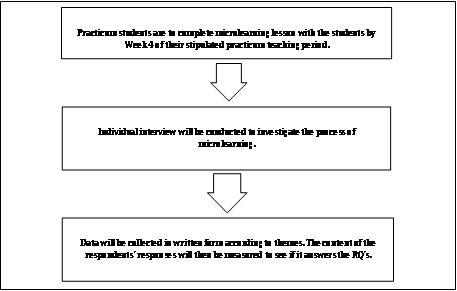The effectiveness of microlearning approach from the perspectives of practicum teachers
Main Article Content
Abstract
Over the past years, practicum teachers have been assigned to schools for their teaching practicum. Many of them tend to struggle with the reduced attention span of students due to online learning. As such, microlearning has been seen to be the most recent method of teaching that could aid students to learn better. This research focuses on the interaction and relativity of microlearning with practicum teachers in the teaching and learning process. 8 groups of 20 students in each group were selected using a convenience sampling method, as the group of students were easily accessed by the researcher, and the practicum teachers acted as the data collectors for this research. The microlearning tool used to replace the traditional teaching method was a 3-minute video and images.. All selected students are in the same level of studies which is in Year 8. Majority of them have the same proficiency level which is upper intermediate. The results show that microlearning did help with their classroom management and students were able to practise their scaffolding skills in a more effective manner.
Article Details

This work is licensed under a Creative Commons Attribution-NonCommercial-NoDerivatives 4.0 International License.
References
Corbeil, R. & Corbeil, M.E. (2023). Microlearning: The “OG” or Hot New Trend? EDUCAUSE Review. https://er.educause.edu/articles/2023/8/microlearning-the-og-or-hot-new-trend#:~:text=In%202020%2C%20microlearning%20adoption%20grew,mode%20of%20choice%20by%202025.
Díaz Redondo, R. P., Caeiro Rodríguez, M., López Escobar, J.J., & Fernández Vilas, A. (2021). Integrating micro-learning content in traditional e-learning platforms. Multimedia Tools and Applications, 80(2), 3121–3151.
Edge, D., Fitchett, S., Whitney, M., & Landay, J. (2012). MemReflex: adaptive flashcards for mobile microlearning. Paper presented at the Proceedings of the 14th international conference on Human-computer interaction with mobile devices and services. Association for Computing Machinery.
Fitria, T. N., Afdaleni, Simbolon, N. E., & Suamba, I. B. P. (2022). Online Learning Implementation and Challenges during COVID-19 Pandemic: English Lecturers’ Perspective in Indonesia. SOSHUM : Jurnal Sosial Dan Humaniora, 12(2), 171–183.
Fitria, T. N. (2022). Students’ Readiness of the Implementation of Face-To-Face Learning at English Class in the Academic Year 2021/2022. ETERNAL (English, Teaching, Learning, and Research Journal), 8(1), 184-199.
Khong, H. K., & Kabilan, M. K. (2020). A theoretical model of micro-learning for second language instruction. Computer Assisted Language Learning, 7(1), 1483–1506.
Kroening, K. (2023). How to Combat Shorter Attention Spans with Engaging Training. Knowledge Anywhere. https://www.knowledgeanywhere.com/resources/article-detail/how-to-combat-shorter-attention-spans-with-engaging-training
Kulhanek, B., & Mandato, K. (2022). Healthcare Technology Training: An Evidence- based Guide for Improved Quality. Springer Nature.
Leong, K., Sung, A., Au, D., & Blanchard, C. (2020). A review of the trend of microlearning. Journal of Work-Applied Management, 13(1), 88–102.
Ozdamli, F., Kocakoyun, S., Sahin, T., & Akdag, S. (2016). Statistical reasoning of impact of infographics on education. Procedia Computer Science, 102(2016), 370 – 37.
Palmer, K., & Blake, D. (2018). The Expertise Economy: How the Smartest Companies Use Learning to Engage, Compete and Succeed. Hachette UK.
Park, Y., & Kim, Y. (2018). A Design and Development of micro-Learning Content in e-Learning System. International Journal on Advanced Science, Engineering and Information Technology, 8(1), 56 – 61.
Senom, F., Zakaria, A.R., & Shah, S. A. R. (2013). Novice Teachers’ Challenges and Survival: Where do Malaysian ESL Teachers Stand? American Journal of Educational Research, 1(4), 119 – 125.

